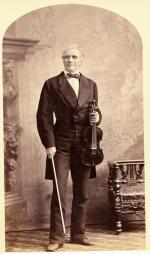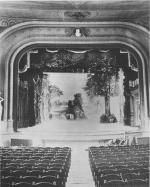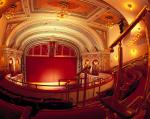![header=[Marker Text] body=[Built in 1852 and named Fulton Hall in honor of Robert Fulton. It is considered an excellent example of the 19th century "Opera House." For more than 75 years, every major star of the American theatre appeared on its stage.] sign](http://explorepahistory.com/kora/files/1/10/1-A-255-139-ExplorePAHistory-a0h7v1-a_450.jpg)
Mouse over for marker text
Name:
Fulton Opera House
Region:
Hershey/Gettysburg/Dutch Country Region
County:
Lancaster
Marker Location:
N. Prince St. between King and Orange Sts., Lancaster
Dedication Date:
October 11, 1952
Behind the Marker
"There is a sense of memory that lives in these buildings," observed one of the architects who helped oversee the nearly two-year renovation of the Fulton Opera House, Lancaster's "Grand Old Lady of Prince Street" in the mid-1990s. "Older buildings are like holy places. They're like shrines, and people have memories that connect to that."
And such memories, passed down through generations, have a marvelous way of cementing a community by forming a shared gathering place. Which was precisely the reason the Fulton Opera House was built: as a place for the citizens of Lancaster to come together.
When the county's new prison went up in the late 1840s, Christopher Hagar, a local merchant and civic leader, set his dream into motion; he reclaimed the site of the old prison and invigorated it with a community pride. Using part of the foundation of the old jail - the old prison wall is still visible at the building's rear - he built Fulton Hall. Hagar named his gathering place in honor of famed county native Robert Fulton, the inventor of the steamboat, whose statue resides in a niche on the face of the four-story Italianate façade above the entrance. A week after a civic celebration opened its doors in October of 1852, Fulton Hall hosted its first professional entertainment, a concert by the great Norwegian violinist Ole Bull to an SRO audience of more than 1,200.
Internally, its original structure couldn't have been more utilitarian. Its open main room with a simple platform stage on one end and a balcony overhanging the other proved a versatile venue for concerts, lectures, meetings and traveling theatrical troupes. Actors Edwin Forrest, Edwin Booth and his brother, Lincoln's assassin John Wilkes Booth - stellar tragedians of the day - were among the hall's early performers. In 1856, the county Republican Party was formed here. During the Civil War, local militia drilled here, and several benefits were held to raise money for returning soldiers.
Edwin Forrest, Edwin Booth and his brother, Lincoln's assassin John Wilkes Booth - stellar tragedians of the day - were among the hall's early performers. In 1856, the county Republican Party was formed here. During the Civil War, local militia drilled here, and several benefits were held to raise money for returning soldiers.
In 1873, local showman Blasius Yecker imposed his grander vision on the hall. He gutted and enlarged the interior, ornately rebuilding it with the most modern conveniences and sophisticated acoustical technology of the time. Reopened as the Fulton Opera House, it continued to lure top-drawer talent from beyond the area, including such popular stars as Joseph Jefferson, Sarah Bernhardt, Maude Adams, and an assortment of Barrymores and Drews. William Jennings Bryan and Mark Twain lectured from the stage. John Philip Sousa roused audiences with his marches. And the Lancaster Operatic Company grew into a cherished cultural staple.
Barrymores and Drews. William Jennings Bryan and Mark Twain lectured from the stage. John Philip Sousa roused audiences with his marches. And the Lancaster Operatic Company grew into a cherished cultural staple.
Still, changing tastes demanded accommodations, and the Fulton Opera House was forced to make its share through the twentieth century. Modifications in 1904 adjusted the theater for the needs of vaudeville, and a projection booth helped the opera house morph into a movie theater in 1930. By the mid-1950s, though, the Fulton Opera House, relegated to screening second- and third-run films, appeared to be running out of steam. There were even rumblings about razing it.
But the community rallied. Within a decade, a non-profit organization was formed to own, operate, and ultimately renovate the theater, and by 1996, that renovation, complete with new 560-seat main stage, practice rooms, and recital stage had at last been accomplished. The renovation sent an important message: with much of its nearly $10 million cost raised by local contributions, the community clearly still felt its connection to the Grand Old Lady of Prince Street.
Today, the Fulton Opera House is a cultural hub of Lancaster County, a thriving regional theater that's home to the Actors Company of Pennsylvania, the Lancaster Symphony Orchestra, the Lancaster Opera Company, and a regular home away from home for national theatrical and concert tours. In 1969, it joined Philadelphia's Walnut Street Theater and Altoona's
Walnut Street Theater and Altoona's  Mishler Theater as one of just three Pennsylvania theaters on the National Register of Historic Places.
Mishler Theater as one of just three Pennsylvania theaters on the National Register of Historic Places.
"There is a sense of memory that lives in these buildings," observed one of the architects who helped oversee the nearly two-year renovation of the Fulton Opera House, Lancaster's "Grand Old Lady of Prince Street" in the mid-1990s. "Older buildings are like holy places. They're like shrines, and people have memories that connect to that."
And such memories, passed down through generations, have a marvelous way of cementing a community by forming a shared gathering place. Which was precisely the reason the Fulton Opera House was built: as a place for the citizens of Lancaster to come together.
When the county's new prison went up in the late 1840s, Christopher Hagar, a local merchant and civic leader, set his dream into motion; he reclaimed the site of the old prison and invigorated it with a community pride. Using part of the foundation of the old jail - the old prison wall is still visible at the building's rear - he built Fulton Hall. Hagar named his gathering place in honor of famed county native Robert Fulton, the inventor of the steamboat, whose statue resides in a niche on the face of the four-story Italianate façade above the entrance. A week after a civic celebration opened its doors in October of 1852, Fulton Hall hosted its first professional entertainment, a concert by the great Norwegian violinist Ole Bull to an SRO audience of more than 1,200.
Internally, its original structure couldn't have been more utilitarian. Its open main room with a simple platform stage on one end and a balcony overhanging the other proved a versatile venue for concerts, lectures, meetings and traveling theatrical troupes. Actors
In 1873, local showman Blasius Yecker imposed his grander vision on the hall. He gutted and enlarged the interior, ornately rebuilding it with the most modern conveniences and sophisticated acoustical technology of the time. Reopened as the Fulton Opera House, it continued to lure top-drawer talent from beyond the area, including such popular stars as Joseph Jefferson, Sarah Bernhardt, Maude Adams, and an assortment of
Still, changing tastes demanded accommodations, and the Fulton Opera House was forced to make its share through the twentieth century. Modifications in 1904 adjusted the theater for the needs of vaudeville, and a projection booth helped the opera house morph into a movie theater in 1930. By the mid-1950s, though, the Fulton Opera House, relegated to screening second- and third-run films, appeared to be running out of steam. There were even rumblings about razing it.
But the community rallied. Within a decade, a non-profit organization was formed to own, operate, and ultimately renovate the theater, and by 1996, that renovation, complete with new 560-seat main stage, practice rooms, and recital stage had at last been accomplished. The renovation sent an important message: with much of its nearly $10 million cost raised by local contributions, the community clearly still felt its connection to the Grand Old Lady of Prince Street.
Today, the Fulton Opera House is a cultural hub of Lancaster County, a thriving regional theater that's home to the Actors Company of Pennsylvania, the Lancaster Symphony Orchestra, the Lancaster Opera Company, and a regular home away from home for national theatrical and concert tours. In 1969, it joined Philadelphia's
Beyond the Marker








